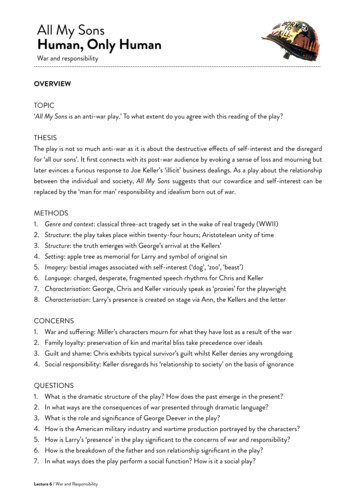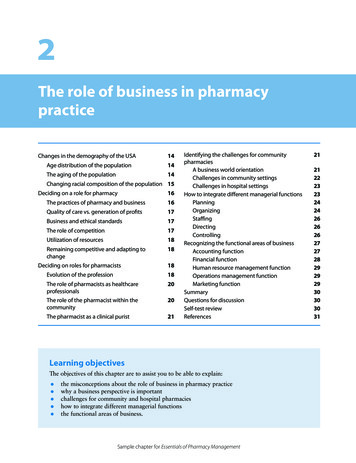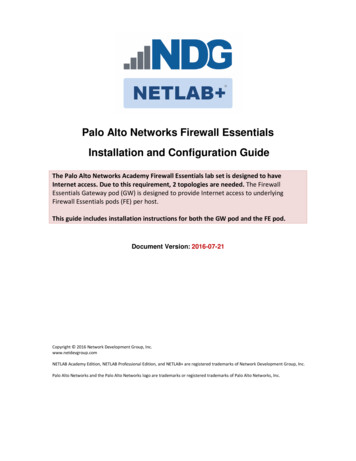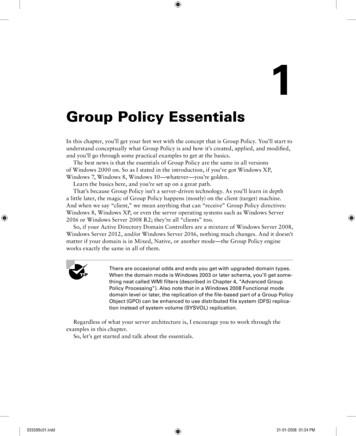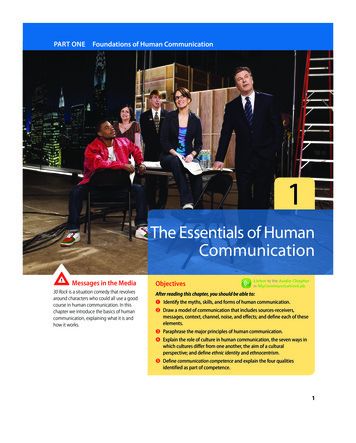
Transcription
PART ONEFoundations of Human Communication1The Essentials of HumanCommunicationMessages in the Media30 Rock is a situation comedy that revolvesaround characters who could all use a goodcourse in human communication. In thischapter we introduce the basics of humancommunication, explaining what it is andhow it works.ObjectivesListen to the Audio Chapterin MyCommunicationLabAfter reading this chapter, you should be able to:➊ Identify the myths, skills, and forms of human communication.➋ Draw a model of communication that includes sources-receivers,messages, context, channel, noise, and effects; and define each of theseelements.➌ Paraphrase the major principles of human communication.➍ Explain the role of culture in human communication, the seven ways inwhich cultures differ from one another, the aim of a culturalperspective; and define ethnic identity and ethnocentrism.➎ Define communication competence and explain the four qualitiesidentified as part of competence.1M01 DEVI3066 CH01 pp001-023.indd 112/7/12 12:00 PM
2Chapter 1 The Essentials of Human CommunicationOf all the knowledge and skills you have, those concerning communication are amongyour most important and useful. Your communication ability will influence how effectively you live your personal and professional life; it will influence your effectiveness as afriend and lover. It will often make the difference between getting a job and not getting it.Your communication skills will determine your influence and effectiveness as a group member and your emergence as group leader. Your communication skills will increase your abilityto communicate information and influence the attitudes and behaviors of others in a varietyof public speaking situations.This first section introduces human communication, beginning with the skills and formsof human communication and some of the popular but erroneous beliefs that can get in theway of effective communication.Preliminaries to Human CommunicationExplore the Exercise“I’d Prefer to Be” atMyCommunicationLabHuman communication consists of the sending and receiving of verbal and nonverbal messages between two or more people. This seemingly simple (but in reality quite complex) process is the subject of this book, to which this chapter provides a foundation. Here we beginthe study of human communication by looking first at the myths about communication (toget rid of them), the skills you’ll learn, and the forms of communication discussed here.Myths About Human CommunicationA good way to begin your study of human communication is to examine just a few ofthe popular but erroneous beliefs about communication, many of which are contradictedby research and theory. Understanding these myths and why they are false will help eliminate potential barriers and pave the way for more effective and efficient learning aboutcommunication.The more you communicate, the better your communication will be. Although this proposition seems logical—the same idea lies behind the popular belief that practice makesperfect—it actually is at the heart of much faulty learning. Practice may help make yourcommunication perfect if you practice the right habits. But if you practice bad habits,you’re likely to grow less, rather than more, effective. Consequently, it’s important to learnand practice the principles of effectiveness.Communication W hen two people are in a close relationship, neither person should have to communiChoice Pointcate needs and wants explicitly; the other person should know what these are. ThisChoices and Humanassumption is at the heart of many interpersonal difficulties. People aren’t mind readCommunicationers, and to expect them to be sets up barriers to open and honest communication.Throughout this book you’llfind marginal items labelled Communication I nterpersonal or group conflict is a reliable sign that the relationship or group is introuble. Conflict is inevitable in relationships and in groups. If the conflict is manChoice Points. These items are designed to enaged effectively, it may actually benefit the individuals and the relationship.courage you to apply the material discussed inthe text to specific communication situations L ike good communicators, leaders are born, not made. Although some people areby first analyzing your available choices andbetter suited to leadership than others, leadership, like communication andthen making a communication decision.listening, is a learned skill. You’ll develop leadership abilities as you learn theprinciples of human communication and those unique to group communicationand group leadership. Fear of speaking in public is detrimental and must be eliminated. Most speakers are nervous—and, to be perfectly honest, you’re probably not going to learn from this book orthis course to eliminate what is commonly called stage fright or communication apprehension. But you can learn to manage your fear, making it work for you rather thanagainst you; you can learn, and this is crucial, to become a more effective speaker regardless of your current level of anxiety. M01 DEVI3066 CH01 pp001-023.indd 212/7/12 12:00 PM
3Preliminaries to Human CommunicationSkills of Human CommunicationAmong the skills you’ll learn through your study of human communication are these: Self-presentation skills enable you to present yourself as (andjust for starters) a confident, likable, approachable, and credibleperson. It is also largely through your communication skills (orlack of them) that you display negative qualities.Relationship skills help you build friendships, enter into loverelationships, work with colleagues, and interact with familymembers. These are the skills for initiating, maintaining, repairing,and sometimes dissolving relationships of all kinds.Interviewing skills enable you to interact to gain information, tosuccessfully present yourself to get the job you want, and to participate effectively in a wide variety of other interview types. (Thistopic is covered in a separate supplement, The InterviewingGuidebook.)Group interaction and leadership skills help you participateeffectively in relationship and task groups—informative, problemsolving, and brainstorming groups, at home or at work—as amember and as a leader.Presentation or public speaking skills will enable you to manage your fear and make it work for you, rather than against you.These skills will enable you to communicate information tosmall and large audiences and influence their attitudes andbehaviors.ViewpointsImportance of CommunicationWomen often report that an essential quality—perhaps themost important quality—in a partner is the ability to communicate. And managers and employment interviewers routinelylist communication skills among the most important jobrelated skills in a desirable employee. How important,compared to all the other factors you might take into consideration in choosing a partner or in succeeding at work, is theability to communicate? What specific communication skillswould you consider “extremely important” in a life partner?You’ll learn these skills and reap the benefits as you develop facility inthe varied forms of communication, to which we now turn.Forms of Human CommunicationYou’ll accomplish these objectives and acquire these skills as you engage in and master avariety of human communication forms. Intrapersonal communication is the communication you have with yourself—when you talk with, learn about, and judge yourself. Youpersuade yourself of this or that, reason about possible decisions to make, and rehearsemessages that you plan to send to others. In intrapersonal communication you might, forexample, wonder how you did in an interview and what you could have done differently.You might conclude you did a pretty good job but tell yourself you need to be more assertivewhen discussing salary.Interpersonal communication occurs when you interact with a person with whomyou have some kind of relationship; it can take place face-to-face as well as throughelectronic channels (e-mail or instant messaging, for example) or even in traditionalletter writing. Perhaps you might e-mail your friends or family about your plans for theweekend, ask someone in class for a date, or confront a colleague’s racist remarks atthe water cooler. Through interpersonal communication you interact with others, learnabout them and yourself, and reveal yourself to others. Whether with new acquaintances,old friends, lovers, family members, or colleagues at work, it’s through interpersonalcommunication that you establish, maintain, sometimes destroy, and sometimes repairpersonal relationships.Interviewing is a form of interpersonal communication that proceeds by question andanswer. Through interviewing you learn about others and what they know, counsel or getcounseling from others, and get or don’t get the job you want. Today much interviewing(especially initial interviews) takes place through e-mail, phone conferencing, or videoconferencing with Skype, for example.M01 DEVI3066 CH01 pp001-023.indd 312/7/12 12:00 PM
4Chapter 1 The Essentials of Human CommunicationRead the “Media Literacy boxes”at MyCommunicationLabSmall group communication or team communication is communication among groups of, say five to ten people and may takeplace face-to-face or, increasingly, in virtual space. Small groupcommunication serves relationship needs—such as those forcompanionship, affection, or support—and task needs—such asbalancing the family budget, electing a new chairperson, or designing a new ad campaign. Through small group communication youinteract with others, solve problems, develop new ideas, and shareknowledge and experiences.Public communication is communication between a speaker andan audience. Audiences range in size from several people to hundreds,thousands, and even millions. Through public communication aspeaker will inform and persuade you. And you, in turn, inform andpersuade others—to act, to buy, or to think in a particular way. Muchas you can address large audiences face-to-face, you also can addresssuch audiences electronically. Through social networks, newsgroups,or blogs, for example, you can post your “speech” for anyone to readand then read their reactions to your message. In addition, with the help of the more traditional mass media of radio and television, you can address audiences in the hundreds of millions as they sit alone or in small groups all over the world.Computer-mediated communication is a general term that includes all forms of communication between people that take place through some kind of computer, whether it’s onyour smartphone or via a standard Internet connection. Examples include e-mail, blogging,instant messaging, or posting or chatting on social network sites such as Facebook, Google ,or Twitter. Throughout this text, we’ll make frequent reference to the similarities and differences between face-to-face and computer-mediated communication.Mass communication refers to communication from one source to many receivers whomay be scattered throughout the world. Newspapers, magazines, radio, television, and filmare the major mass media. Recently media literacy—the skills and competencies needed tobecome a wiser, more critical consumer—has become central to the study of human communication. Accordingly, the coverage of mass communication here is limited to medialiteracy—a topic covered in the chapter-opening photos, in frequent examples, illustrations,and exercises, and the inclusion of a variety of Media Literacy boxes at MyCommunicationLab.This text focuses on all these forms of communication—and on you as both messagesender and message receiver. It has two major purposes: To explain the concepts and principles, the theory and research in human communication,so that you’ll have a firm understanding of what communication is and how it works.To provide you with skills of human communication that will help you increase yourcommunication competence and effectiveness in your personal and professional lives.Objectives Self-Check Can you identify the myths that can hinder the study of communication? Can you identify the wide variety of skills you’ll learn as you progress through this course? Can you identify the forms of human communication to be covered here?Communication Models and ConceptsFor some advice for beginning college students, see “To BeginningStudents” at tcbdevito.blogspot.com. What additional advicewould you want?M01 DEVI3066 CH01 pp001-023.indd 4In early models (representations) or theories, the communication process was thought to belinear. According to this linear view, the speaker spoke and the listener listened. Communication was seen as proceeding in a relatively straight line. Speaking and listening were seen astaking place at different times; when you spoke, you didn’t listen, and when you listened, youdidn’t speak (Figure 1.1).12/7/12 12:01 PM
5Communication Models and ConceptsA more satisfying view, the one held currently, sees communicationas a transactional process in which each person serves as both speakerand listener, sending and receiving messages (Watzlawick, Beavin, &Jackson, 1967; Watzlawick, 1977, 1978; Barnlund, 1970). In face-to-facecommunication, while you send messages you’re also receiving messagesfrom your own communications and from the reactions of the other person. This is also true in phone communication, in instant messaging, andin chatting. Other online communications, such as posting on Facebookor e-mail, more closely resemble the linear model of communicationwhere sending and receiving occur at different times.The transactional view also sees the elements of communication asinterdependent (never independent). This means that each elementexists in relation to the others. A change in any one element of theprocess produces changes in the other elements. For example, if you’rehaving a meeting with a group of your coworkers and your boss entersthe room, this change in “audience” will lead to other changes. Perhapsyou’ll change what you’re saying or how you’re saying it. Regardless ofwhat change is introduced, other changes will occur as a result.Communication occurs when you send or receive messages andwhen you assign meaning to another person’s signals. All humancommunication occurs within a context, is transmitted via one ormore channels, is distorted by noise, and has some effect. We canexpand the basic transactional model of communication by addingthese essential elements, as shown in Figure 1.2.SpeakerListenerFigure 1.1The Linear View of Human CommunicationThe speaker speaks and the listener listens.ContextMee s / Ch a n n es s aglsFe e db a c ver/decoderMeFeedbacks s a ge s C h a n n e igure 1.2According to the transactional model, each person involved in comTheEssentials of Human Communicationmunication is both a source (speaker) and a receiver (listener); henceThis is a general model of communication between two peoplethe term sources–receivers. You send messages when you speak, write,and most accurately depicts communication as a transactionalgesture, or smile. You receive messages in listening, reading, seeing,process. It puts into visual form the various elements of thesmelling, and so on. At the same time that you send messages, you’recommunication process. How would you revise this model toalso receiving messages: You’re receiving your own messages (you hear depict small group interaction or public speaking?yourself, feel your own movements, see many of your own gestures),and, at least in face-to-face communication, you’re receiving the messages of the other person—visually, auditorily, or even through touch or smell. As you speak,you look at the person for responses—for approval, understanding, sympathy, agreement, andso on. As you decipher these nonverbal signals, you’re performing receiver functions. Whenyou write to or text someone with video; the situation is very similar to the face-to-face situaExplore the Exercisetion. Without video, you might visualize the responses you expect/want the person to give.“Comparing HumanWhen you put your ideas into speech, you’re putting them into a code; hence you’reCommunication” atMyCommunicationLabencoding. When you translate the sound waves (the speech signals) that impinge on yourears or read the words on a screen, into ideas, you take them out of the code they’re in; henceyou’re decoding. Thus, speakers or writers are often referred to as encoders, and listeners orreaders as decoders. The linked term encoding–decoding emphasizes the fact that you perform these functions simultaneously.Usually, you encode an idea into a code that the other person understands—for example, English, Spanish, or Indonesian, depending on the shared knowledge that you and your listener possess.At times, however, you may want to exclude others by speaking in a language that only one of yourlisteners knows or by using jargon. The use of abbreviations and jargon in text messaging is another example of how people communicate in a code that only certain people will understand.MessagesCommunication messages take many forms and are transmitted or received through one ormore sensory organs or a combination of them. You communicate verbally (with words) andM01 DEVI3066 CH01 pp001-023.indd 512/7/12 12:01 PM
6Chapter 1 The Essentials of Human Communicationnonverbally (without words). Your meanings or intentions are conveyed with words (Chapter4) and with the clothes you wear, the way you walk, and the way you smile (Chapter 5). Everything about you communicates a message.Feedforward Messages Feedforward is information you provide before sending yourprimary messages (Richards, 1951). It reveals something about the messages to come and inExplore the Exercisecludes, for example, the preface or table of contents of a book, the opening paragraph of a“How to Give Feedforward” atchapter, movie previews, magazine covers, and introductions in public speeches.MyCommunicationLabFeedforward may be verbal (“Wait until you hear this one”) or nonverbal (a prolongedpause or hands motioning for silence to signal that an important message is about to be spoken). Or, as is most often the case, it is some combination of verbal and nonverbal. Feedforward may refer to the content of the message to follow (“I’ll tell you exactly what they said toeach other”) or to the form (“I won’t spare you the gory details”). In e-mail, feedforward isgiven in the header, where the name of the sender, the date, and the subject of theCommunicationmessage are identified. Caller ID is also an example of feedforward.Choice PointAnother type of feedforward is phatic communication—“small talk” that opensGiving Feedforwardthe way for “big talk.” It includes the “How are you?” and “Nice weather” greetingsThe grades were just postedthat are designed to maintain rapport and friendly relationships (Placencia, 2004;for a course, and you see that your dormBurnard, 2003). Similarly, listeners’ short comments that are unrelated to the contentmate failed. You got an A. Your dorm mateof the conversation but indicate interest and attention also may be considered phaticasks you about the grades. You feel youcommunication (McCarthy, 2003).want to preface your remarks. What kind offeedforward might you give in this case?Feedback Messages When you send a message—say, in speaking to anotherperson—you also hear yourself. That is, you get feedback from your own messages;you hear what you say, you feel the way you move, you see what you write. In addition to thisself-feedback, you also get feedback from others. This feedback cantake many forms. A frown or a smile, a yea or a nay, a returned pokeor a retweet, a pat on the back or a punch in the mouth are all types offeedback.Feedback tells the speaker what effect he or she is having on listeners. On the basis of feedback, the speaker may adjust, modify,strengthen, deemphasize, or change the content or form of the messages. For example, if someone laughs at your joke (giving you positivefeedback), it may encourage you to tell another one. If the feedback isnegative—no laughing, just blank stares—then you may resist relayinganother “humorous” story.Metamessages A metamessage is a message that refers to an-ViewpointsFeedbackBased on your own experiences, do you find that peoplewho accurately read and respond to feedback are betterliked than those who don’t read feedback as accurately?In what ways might the ability to give effective feedbackinfluence the growth or deterioration of a relationship? Isthere a relationship between the ability to read feedbackand the ability to communicate information or to persuade an audience?M01 DEVI3066 CH01 pp001-023.indd 6other message; it is communication about communication. For example, remarks such as “This statement is false” or “Do you understandwhat I am trying to tell you?” refer to communication and are therefore “metacommunicational.”Nonverbal behavior may also be metacommunicational. Obvious examples include crossing your fingers behind your back orwinking when telling a lie. On a less obvious level, consider theblind date. As you say, “I had a really nice time,” your nonverbalmessages—the lack of a smile, failure to maintain eye contact—metacommunicate and contradict the verbal “really nice time,” suggesting that you did not enjoy the evening. Nonverbal messagesmay also metacommunicate about other nonverbal messages. Theindividual who, on meeting a stranger, both smiles and extends atotally lifeless hand shows how one nonverbal behavior may contradict another.Workplace Messages In workplace organizations messages areoften classified in terms of their direction.12/7/12 12:01 PM
Communication Models and Concepts7 Upward communication consists of messages sent from thelower levels of a hierarchy to the upper levels—for example, fromline worker to manager, or faculty member to dean. This type ofcommunication usually is concerned with job-related activitiesand problems; ideas for change and suggestions for improvement;and feelings about the organization, work, other workers, or similar issues. Downward communication consists of messages sent from thehigher levels to the lower levels of the hierarchy—for example,messages sent by managers to workers or by deans to facultymembers. Common forms of downward communication includeorders; explanations of procedures, goals, and changes; andappraisals of workers.Lateral communication refers to messages between equals—manager-to-manager, worker-to-worker. Such messages maymove within the same subdivision or department of the orgaViewpointsnization or across divisions. Lateral communication, for example, is the kind of communication that takes place betweenSynchronous and Asynchronous Communicationtwo history professors at Illinois State University, between aIn face-to-face and in much online communication, mespsychologist at Ohio State and a communicologist at Kentsages are exchanged with virtually no delay; communicationState, or between a bond trader and an equities trader at ais synchronous. In other forms of communication—for example, snail or e-mail and blog posts—the messages may bebrokerage house.exchanged with considerable delay; communication here isGrapevine communication messages don’t follow any of the forasynchronous. What differences does this lead to in the waymal, hierarchical lines of communication established in an orgayou communicate in these various forms?nization; rather, they seem to have a life of their own. Grapevinemessages concern job-related issues that you want to discuss in amore interpersonal setting—for example, organizational issues that have not yet beenmade public, the real relationship among the regional managers, or possible changes thatare being considered but not yet finalized. Communication ContextCommunication exists in a context that determines, to a large extent, the meaning ofany verbal or nonverbal message. The same words or behaviors may have totally different meanings when they occur in different contexts. For example, the greeting“How are you?” means “Hello” to someone you pass regularly on the street but “Isyour health improving?” to a friend in the hospital. A wink to an attractive personon a bus means something completely different from a wink that signifies a put-onor a lie. Divorced from the context, it’s impossible to tell what meaning was intendedfrom just examining the signals.The context will also influence what you say and how you say it. You communicate differently depending on the specific context you’re in. Contexts have at leastfour aspects: physical, cultural, social-psychological, and temporal or time. CommunicationChoice PointMessage OverloadSeveral relatives have developed chain e-mail lists and send you virtually everything they come upon as they surfthe Internet. You need to stop this e-mailoverload. But, most of all, you don’t want toinsult your relatives or make them feelguilty. What are some of the things you mightsay? What are the advantages and disadvantages of saying nothing?The physical context is the tangible or concrete environment, the room, park, orauditorium; you don’t talk the same way at a noisy football game as you do at a quietfuneral.The cultural context involves the lifestyles, beliefs, values, behavior, and communication of a group; it is the rules of a group of people for considering something right orwrong.The social-psychological context has to do with the status relationships amongspeakers, the formality of the situation, the norms of a group or organization; youdon’t talk the same way in the cafeteria as you would at a formal dinner at yourboss’s house.M01 DEVI3066 CH01 pp001-023.indd 712/7/12 12:01 PM
8Chapter 1 The Essentials of Human Communication The temporal context is a message’s position within a sequence of events; you don’t talkthe same way after someone tells you about the death of a close relative as you do aftersomeone reveals they’ve won the lottery.These four contexts interact—each influences and is influenced by the others. Forexample, arriving late for a date (temporal context) may lead to changes in the degree offriendliness (social–psychological context), which would depend on the cultures of you andyour date (cultural context), and may lead to changes in where you go on the date (physicalcontext).ChannelCommunicationChoice PointThe communication channel is the vehicle or medium through which messages pass.Communication rarely takes place over only one channel. Rather, two, three, or fourchannels may be used simultaneously. In face-to-face conversations, for example,you speak and listen (vocal channel), but you also gesture and receive signals visually(visual channel). You also emit and smell odors (olfactory channel) and often touchone another; this tactile channel, too, is communication.Another way to classify channels is by the means of communication. Thus, faceto-face contact, telephones, e-mail, movies, television, smoke signals, and telegraphall are types of channels.ChannelsYou want to ask someone fora date and are considering how you mightgo about this. What are your choices amongchannels? Which channel would be the mosteffective? Which channel would provoke theleast anxiety?NoiseNoise is anything that interferes with your receiving a message. At one extreme, noise mayprevent a message from getting from source to receiver. A roaring noise or line static can prevent entire messages from getting through to your phone receiver. At the other extreme, withvirtually no noise interference, the message of the source and the message received are almostidentical. Most often, however, noise distorts some portion of the message a source sends as ittravels to a receiver. Just as messages may be auditory or visual, noise comes in both auditoryand visual forms. Four types of noise are especially relevant: Noise of a somewhat different typeis discussed in “The Chain Letter asDysfunctional Communication” attcbdevito.blogspot.com. What’syour opinion of the chain letter? Arethere some chain letters that youview more positively than others? Physical noise is interference that is external to both speaker and listener; it interfereswith the physical transmission of the signal or message and would include the screechingof passing cars, the hum of a computer, sunglasses, blurred type or fonts that are toosmall or difficult to read, misspellings and poor grammar, and popup ads.Physiological noise is created by barriers within the sender or receiver and would include visual impairments, hearing loss, articulation problems, and memory loss.Psychological noise refers to mental interference in the speaker or listener and includespreconceived ideas, wandering thoughts, biases and prejudices, close-mindedness, andextreme emotionalism. You’re likely to run into psychological noise when you talk withsomeone who is close-minded or who refuses to listen to anything he or she doesn’talready believe.Semantic noise is interference that occurs when the speaker and listener have differentmeaning systems; it would include language or dialectical differences, the use of jargon oroverly complex terms, and ambiguous or overly abstract terms whose meanings can beeasily misinterpreted. You see this type of noise regularly in the medical doctor who uses“medicalese” without explanation or in the insurance salesperson who speaks in the jargon of the insurance industry.As you can see from these examples, noise is anything that distorts your receiving themessages of others or their receiving your messages.A useful concept in understanding noise and its importance in communication is signalto-noise ratio. In this term the word signal refers to information that you’d find useful, andnoise refers to information that is useless (to you). So, for example, a post or feed that containslots of us
4 CHAPTER 1 The Essentials of Human Communication Small group communication or team communication is com- munication among groups of, say five to ten people and may ta



